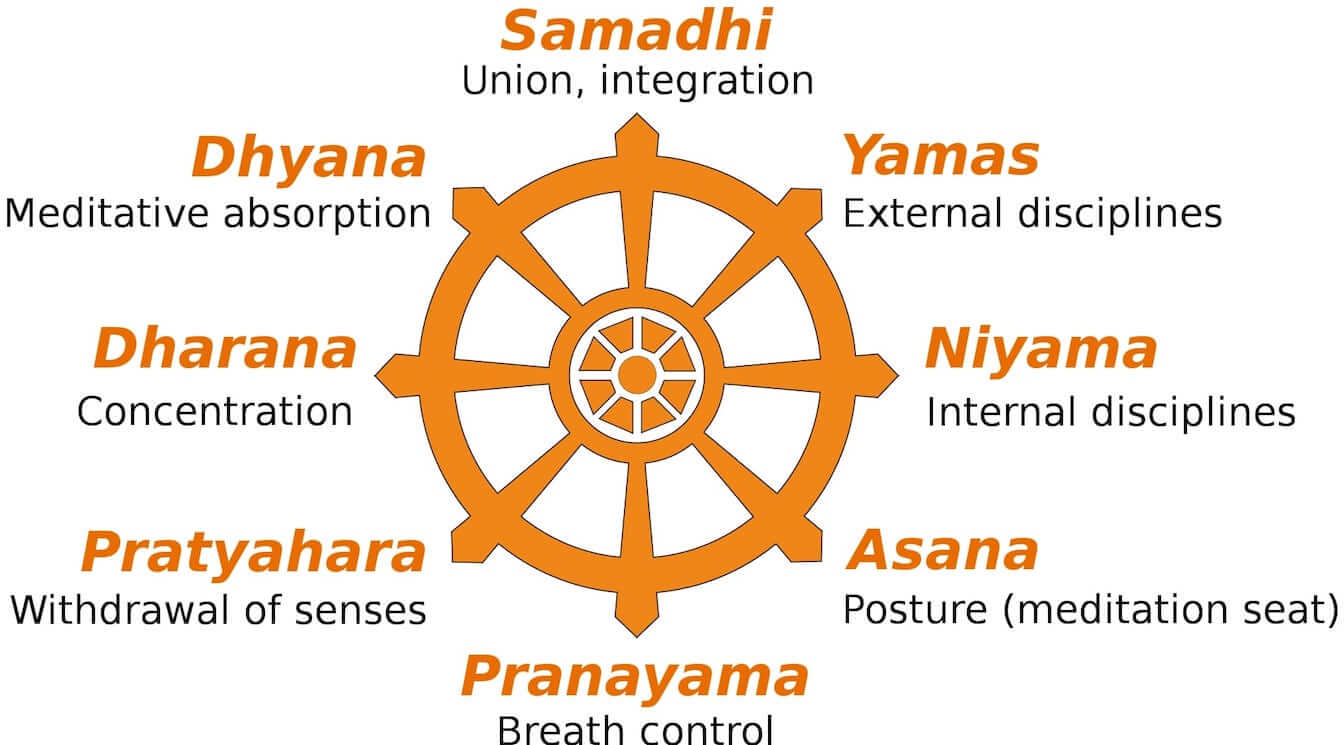The word yoga means ‘to connect’ or ‘to unite’. It is a practice that focuses on the mind and body. Yoga practice involves movement, meditation, deep breathing, and asanas that enrich mental and physical well-being.
The already existing ancient art of Yoga was systematized by the father of yoga, Maharishi Patanjali. There are various types of yoga and one of them is Ashtanga 8 limbs of Yoga. Before diving into the details of each limb of yoga, let us first have an introduction to Ashtanga-8 limbs of yoga.
Introduction to 8 Limbs of Yoga
According to Patanjali’s Yoga Sutra, the ‘eight limbs’ come from the Sanskrit term ‘Ashtanga’ (Asht= Eight and Anga= Limbs). These are the eight steps that guide you to live a meaningful and purposeful life. They also help you to acknowledge the spiritual aspects of your life.
What are the Eight Limbs of Yoga?
The eight limbs of yoga are meant to be learned in the way they are listed here. You must master each step before heading towards the other.
-
Yama
Yama is the first limb that refers to the practices concerned with the world around you. It follows the golden rule of ‘Do unto others as you would have them to do unto you.
Yama has the five ethical precepts that focus on the code of conduct while interacting with the outer world, and they are:
Ahimsa- Non Violence
Satya- Truthfulness
Asteya- Non-stealing
Brahmacharya- Continence
Aparigraha- Non-covetousness
According to BKS Iyengar, “Yamas are unconditioned by time, class and place” which means no matter where you are, where you come from, or how experienced you are, you should instill the Yamas within yourself.
-
Niyama
As the Yama is the outward-looking toward society, the Niyamas are the inward-looking towards yourselves. The prefix ‘Ni’ is the Sanskrit word that means ‘inward’ or ‘within’. Niyama is the second limb of Ashtanga yoga that refers to the duties directed towards yourself.
The five spiritual elements of Niyama are:
Saucha- Cleanliness.
Samtosa- Contentment.
Tapas- Spiritual heat.
Svadhyaya- Study of one’s self.
Isvara Pranidhana- Surrender to God.
Niyamas are traditionally practiced by those who wish to further explore the yogic path.
-
Asanas
The postures practiced in yoga are known as the Asanas. It is the third limb of yoga through which you might develop a sense of discipline and concentration power, which are the necessary elements of life.
The word asana here does not refer to the ability to practice a handstand or a backward bend. It specifically means ‘seat’, the seat you would take to practice various techniques of yoga.
Also Read:- Kundalini Yoga For Beginners
-
Pranayama
Pranayama is generally known as Breath Control. It is the fourth limb of yoga which consists of the techniques of breathing and respiration while establishing the relationship between mind, breath, and emotions. Pranayama can be practiced at any time and at anywhere.
You can practice Pranayama as an isolated technique or integrate it with your daily Hatha yoga routine.
-
Pratyahara
The fifth limb of yoga is Pratyahara, which means withdrawal. This limb helps you to draw your attention away from the external world. The practice of Pratyahara provides you with an opportunity to peep into yourselves and observe the activities you are performing.
It is the first thing you do when you meditate, you focus on yourself, and helps to cut off your senses from the outside world.
The easiest way to practice Pratyahara is to close your eyes while practicing asana.
-
Dharana
The practice of Pratyahara prepares you for Dharana. It is the practice of concentrating on the inner self by cutting out the external distractions. Dharana is practiced prior to meditation practice as in this you will slowly learn to concentrate on a single mental object.
-
Dhyana
Dhyana is the seventh stage of ashtanga which is the meditation process. Dharana and Dhyana may seem the same but they have a fine line between them. Dharana focuses on only one mental object. While Dhyana is the state of keen awareness without focusing on one thing.
-
Samadhi
Patanjali describes Samadhi, the eighth limb, as the state of joy. At this stage, the meditation practitioner comes to realize the connection to the Divine with all living things. You can attain Moksha (permanent state of being free) after you have experienced the state of Samadhi.
Conclusion
Yoga is not the art of sweating and practicing intense exercises on the yoga mat. It is a spiritual form of exercise that has passed on for thousands of years. So, the above mentioned is the overview of 8 limbs of yoga, each of which offers guidance on how to live a conscious, meaningful, and purposeful life.
Moreover, the eight limbs of yoga are interconnected and can be called the essence of life.
Read More:- RYT Certification

